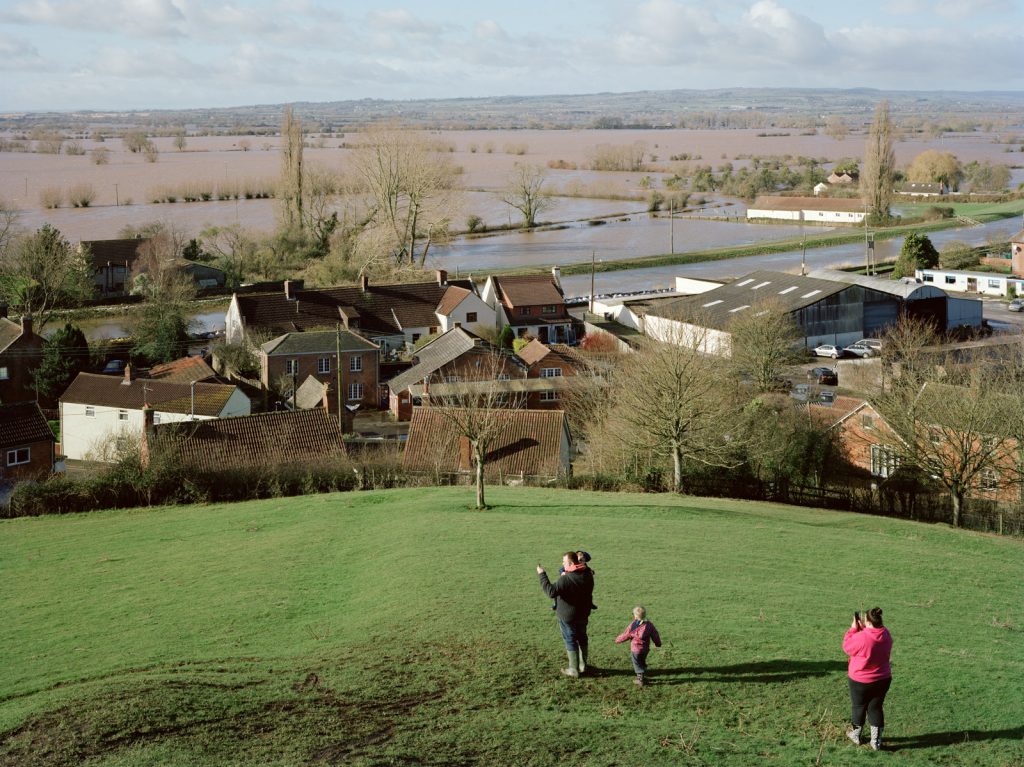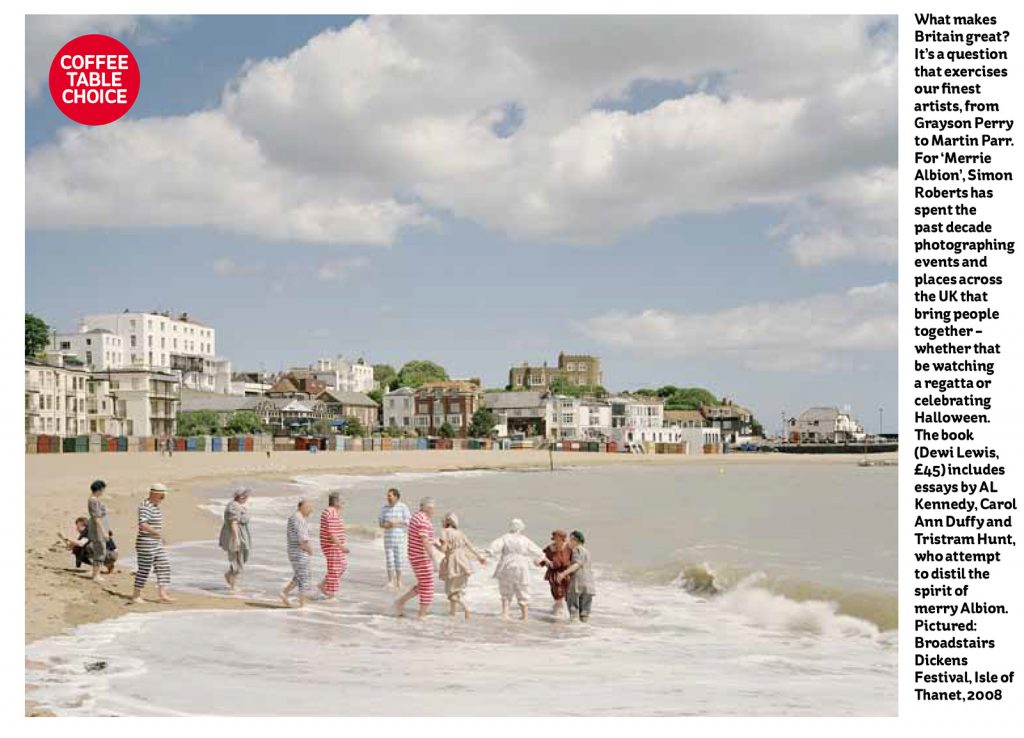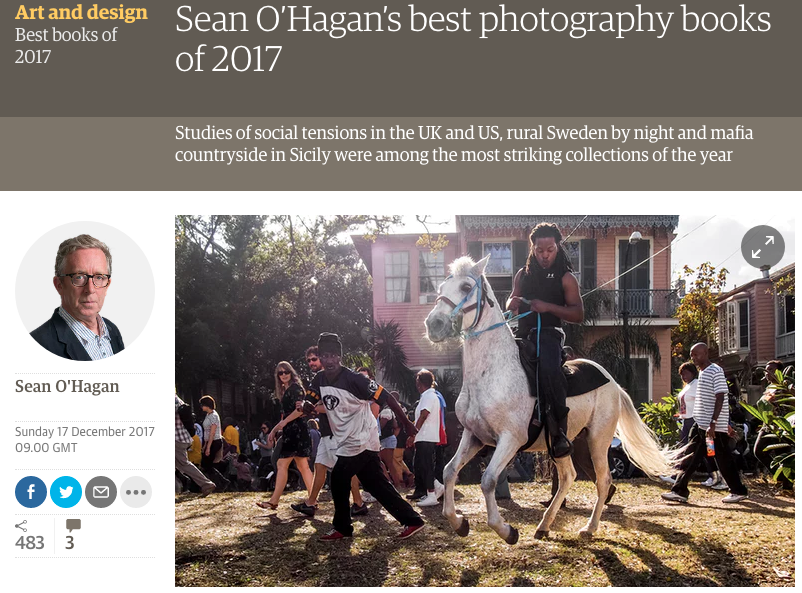Recently I was interviewed by Gemma Padley for the Royal Photographic Society Journal as part of their Best Shots series ahead of my talk at RPS House, Bristol, in October.
You can download a pdf of the article here.
Merrie Albion is reviewed on the Christian Science Monitor here (download a pdf here).
Homeland, my sol exhibition at Flowers Gallery (New York). is reviewed by Daniel Maidman on Whitehot Magazine here (download a pdf here).
and also by Connor Goodwin on Blouin Artinfo here (download a pdf here).
The current issue of British Art Studies‘ Landscape Now publication (Issue 10, Autumn 2018), includes an essay by David Matless where he discusses my photograph ‘Flooding of the Somerset Levels, Burrowbridge, 2014′ from Merrie Albion.
Read ‘The Anthroposcenic: Landscape in the Anthroposcene’ here and download a pdf here.

Flooding of the Somerset Levels, Burrowbridge, Somerset, 11 February 2014
Image: Installation shot from Homeland, Flowers Gallery New York (Clevedon Pier on the left)
To celebrate its 30th anniversary issue Photograph Magazine asked 30 people to choose an image that meant something to them in 2018. Sarah Schmerler, Art Critic and Independent Curator, selected my photograph of Clevedon Pier, which was on show at Flowers Gallery in New York.
“Where are we? How did we get here? Many of Simon Roberts’s pictures beg those sorts of deep questions, but this one in particular compels me [Clevedon Pier]. It is melancholy, delicate, yet strong. Here I am in a world that, at least for a moment, has been blotted out. The tiny weather vane points north. The British flag hangs limp. Whatever breeze once came through here has since passed. No need to get my bearings now; I know this psychic place because over the last year I have awoken to an America that more and more I don’t recognize. And the tide, it is rising.” Sarah Schmerler, January 2019.
Download PDF here.
Merrie Albion – Landscape Studies of a Small Island published in late 2017 (Dewi Lewis Publishing) and was exhibited at Flowers Gallery London in early 2018. The work has garnered several reviews and articles, a selection of which can be read below and pdf is available HERE.
British Journal of Photography
The April 2018 edition of ArtForum reviews Merrie Albion exhibition at Flowers Gallery, London.
“In 2007, Simon Roberts began his series “We English” by training his four-by-five camera on the English landscape and its inhabitants for the first time. Roberts spent several months in a mobile home, traveling across the country to investigate the relationship between the scenery, leisure activities, and English identity. He saw all three as complementary. As he revealed in a talk at Photofusion Photography Centre in London in 2014, his experience of England was informed by his own family trips and holiday activities in the open air, and by the long tradition of British portraiture set in pastoral landscapes.
Just over a decade later, Roberts presented “Merrie Albion—Landscape Studies of a Small Island,” an exhibition and accompanying book demonstrating his long-term devotion to Britain as a subject. It showcased images featuring in some of his most famous series, such as “The Election Project,”2010, along with other photographs he had never exhibited before. An example of the latter was the poignant Grenfell Tower, North Kensington, London, 19 June 2017, depicting, in the distance, the blackened shell of the titular apartment block. Last year, a fire broke out in the structure, spreading through the building with terrifying speed due to the use of cheap, flammable aluminum cladding, and leading to the deaths of at least seventy-one people.
Roberts has remained faithful to the style he mastered in 2007, characterized by a complex multiplane composition, elevated perspective (he often photographs from the top of his motor home), and the tableau format, to use art historian and curator Jean-François Chevrier’s term for a form of photography that, like painting, relates to the wall rather than to the page, and in which characters are otherwise absorbed and seem unaware of the existence of the viewer. In this show, the majority of the exhibited photographs (C-prints) were sixty by seventy-two inches and displayed one or two per wall at eye level. Some works depicted British meadows and rivers as a background for historical reenactments and traditional rituals. A sense of anxiety underpins these scenes. Although the activities aim to reinforce a sense of identity and belonging, all they provide is a momentary distraction from the political and economic unrest of the past decade. Similar escapism fed the recent Brexit campaign: The idea of a serene British landscape became a starting point for a fantasy about an imagined, glorious past in which England was a greater, more independent, more prosperous nation. The show’s title was clearly a reference to this fantasy, with its archaic spelling of merry and its use of the earliest known name for the island of Britain. But scenes like that of the burnt-out Grenfell Tower were a reminder that contemporary Britain has little to do with the pastoral daydream. The building’s charred skeleton looms in the distance while, in the foreground, young people gather in a leafy square, seemingly unbothered by the view—a vista that, through Roberts’s camera, looks like a metaphor for the discrepancy between political fantasies and the country’s real needs.”
Merrie Albion was recently featured as the ‘Coffee Table Book’ of the week by The Independent newspaper (below) and also made Sean O’Hagan’s Top Photobooks list of 2017 in The Observer and Tim Clark’s round-up of Top 10 photobooks list on 1000 Words.


Sean O’Hagan writes:
“Anyone looking for a Christmas present for their Brexiter dad or Remainer mum should seek out Simon Roberts’s big and beautifully designed Merrie Albion: Landscape Studies of a Small Island (Dewi Lewis £45). A portrait of contemporary Britain, it presents the nation in all its complexity, from city traders to Muslim worshippers, while somehow evincing a sense of place that is palpable and oddly reassuring. Shot on a medium format camera, often from an elevated point of view, Roberts sometimes makes composites of the same scene, creating images that have the theatricality of one of his inspirations, William Powell Frith, the 19th-century painter of everyday English tableaux. A book that speaks quietly and powerfully about this increasingly disunited kingdom at a pivotal moment.”
Kitty Grady in the Financial Times writes:
“A visual chronicler, Simon Roberts’ scenes of public gatherings conflate traditional landscape painting with social documentary. His latest exhibition, featuring photos taken during the past 10 years, focuses on events and places that define recent British history, such as student protests, Grenfell Tower and Shoreham Air Show.
In his Brueghel-like compositions of congregation, carnival and revolt, Roberts resists simplistic notions of nationhood. His landscapes, woven with juxtapositions, tensions and ironies, show the fracture of contemporary society.”
Other reviews include this one by Michael Grieve in the BJP –
“Merrie Albion: Landscape Studies of a Small Island is a concise compendium of Britain over the past few years and is an excellent visual survey of the run-up to Brexit. The photographs examine rich and complex variations of Britain that are now even more poignant after last year’s vote. Images of election campaigning in clean and tidy suburbia, protests, the aftermath of riots in London, diamond jubilee celebrations, rock concerts, a family enjoying Brighton beach, computer screens of the trading floor of Lloyds – the list goes on. Roberts has managed to capture all the major events in juxtaposition with minor situations that are large with meaning, from the dead of the Iraq war being saluted by Army veterans through Wootton Bassett to a depiction of impoverished mothers and children at a youth club in Blackburn. Contained within each photograph are mini dramas, cheap-looking high streets with pound shops set against Victorian architecture. Roberts shows a Britain at odds with itself. Rather than a harmonious society, we sense fragmentation and awkwardness and a yearning for a glorious past that never existed.”
Adrian Burnham in The New European writes:
“Roberts’ work celebrates the ebb and flow of group activity by which our society seems to breathe. Except, for me, there’s a choking feeling too. Be it airshow, music festival, countryside event, protest or civic assembly. At one level these denotations of culture afford ideas of positive collectivity in the face of the supposed social disintegration commonly associated with our ever more digital age.
This isn’t socio-economic concern tacked onto a creative visual practice. Roberts studied human geography prior to becoming a photographer and a more and less obvious but always deep concern with the state and fate of people appearing in his work endures.”
In Town and Country, Frances Hedges writes:
Roberts’ scenes range from the joyful – a festival on a Kentish beach, a Diamond Jubilee street party on an estate, Eid al-Fitr celebrations – to the poignant, such as an image of Grenfell Tower in the wake of last summer’s tragic fire. He is interested in the drama that is inherent in certain social customs, religious practices or community rituals, where humans become characters within shared stories. He brings the eye of a documentary photographer to the genre of landscape art, highlighting the complexities of our relationships with both people and our lived environment. At a time when the question of British identity is at the forefront of our national conversations, Roberts’ works paint a challenging picture of a country whose differences are as much a cause for celebration as the characteristics its people have in common.
There’s this one from Rebecca Fulleylove on It’s Nice That:
“This body of work serves as a reminder that the landscapes and environments we live in are shaped by the people that inhabit them. Simon not only provides a survey of Britain’s public spaces but also offers commentary and a topical look at what’s happened in Britain over the last ten years.”
Over on 1000 Words, Tim Clark writes:
“More conventional in format but relying on utterly captivating landscape photography is Simon Roberts’ Merrie Albion: Landscape Studies From A Small Island. Released in the wake of the nationalist triumph of Brexit, this brilliant new book takes the temperature of the UK, offering insights most necessary into notions of identity and belonging and, specifically, what it means to be British at this significant moment in contemporary history. With his customary elevated perspective and tableaux style, we oversee views of places and the people that populate them to form a survey: not only of spaces used for leisure and cultural activity but also subjects and events that can now be viewed as defining locations in recent times, such as the London 2012 Opening Ceremony or Grenfell Tower. A real socio-political mood piece, the power and urgency of which reminds us why Roberts is regarded as one of the leading UK photographers working today.”
Meanwhile, Peggy Roalf includes the book in her feature Top Photo Books for the Holidays for Design Art Daily:
“The photographs examine rich and complex variations of Britain that are now even more poignant after last year’s vote. Images of election campaigning in clean and tidy suburbia, protests, the aftermath of riots in London, diamond jubilee celebrations, rock concerts, a family enjoying Brighton beach, computer screens of the trading floor of Lloyds – the list goes on.
Roberts has managed to capture all the major events in juxtaposition with minor situations that are large with meaning, from the dead of the Iraq war being saluted by Army veterans through Wootton Bassett to an depiction of impoverished mothers and children at a youth club in Blackburn. Contained within each photograph are mini dramas, cheap-looking high streets with pound shops set against Victorian architecture. Roberts shows a Britain at odds with itself.”
And finally this one by Simon Bowcock on Photomonitor:
“Simon Roberts’s aloof and detached approach may be the antithesis of Wood’s, but his new book Merrie Albion is nonetheless full of engaging pictures which reward time spent. Redolent of classic English landscape paintings with their slightly elevated viewpoints and people scattered in the middle-distance (think Constable), they also carry a very contemporary air of detachment and a level of societal detail which invites repeated viewings.”
Necsus: European Journal of Media Studies (Autumn 2016) has a review of my Pierdom work. Written by Brydon, Lavinia and Jenzen, Olu (2016).
Precis:
Review of British photographer Simon Roberts’s project Pierdom, exhibited at the Brighton Museum and Art Gallery in 2015. Interview with Roberts. The review discusses Robert’s work which centres on questions of people and place, particularly in regard to the construction and promotion of national identity both from an aesthetic, historical and cultural studies point of view. The exhibition and its engagement with its audiences is contextualised in relation to the AHRC Connected Communities Research Project ‘The People’s Pier’. Drawing on research findings about local communities and their relation to their pier as a heritage asset and popular culture venue, the review argues the exhibition portrays piers as lived experiences shaped by the mood of the time and the socio-cultural make-up of their location. Roberts captures details which reveal the small economies of British seaside tourism as well as the context of piers in the landscape and the imprint of economic changes in these costal regions. From 2011-2013 Roberts toured the British coastline capturing the country’s 58 surviving pleasure piers as well as a few ‘lost’ piers with a 4×5 inch field camera.
Read the full text here.
NECSUS is an international, double blind peer-reviewed journal of media studies connected to NECS (European Network for Cinema and Media Studies) and published by Amsterdam University Press. The journal is multidisciplinary and strives to bring together the best work in the field of media studies across the humanities and social sciences. We aim to publish research that matters and that improves the understanding of media and culture inside and outside the academic community.
Pierdom is featured in the Autumn issue of NECSUS (European Network for Cinema and Media Studies), reviewed by Lavinia Brydon (University of Kent) and Olu Jenzen (University of Brighton).
NECSUS is an international, double blind peer-reviewed journal of media studies connected to NECS and published by Amsterdam University Press.
You can read the piece here:
Image: Pierdom installation at Brighton Museum & Art Gallery / Photo by James Pike.
Photomonitor have reviewed my Pierdom exhibition.
“Pierdom is an elegant show with a long-shelf life and it will, no doubt, become part of an archive of British heritage. It is also a very personal response by Roberts to a cultural icon that is part of the British psyche.” Miranda Gavin, January 2016
You can read the full review here.
Pierdom will continue to be on show until 20 February 2016. More details here.